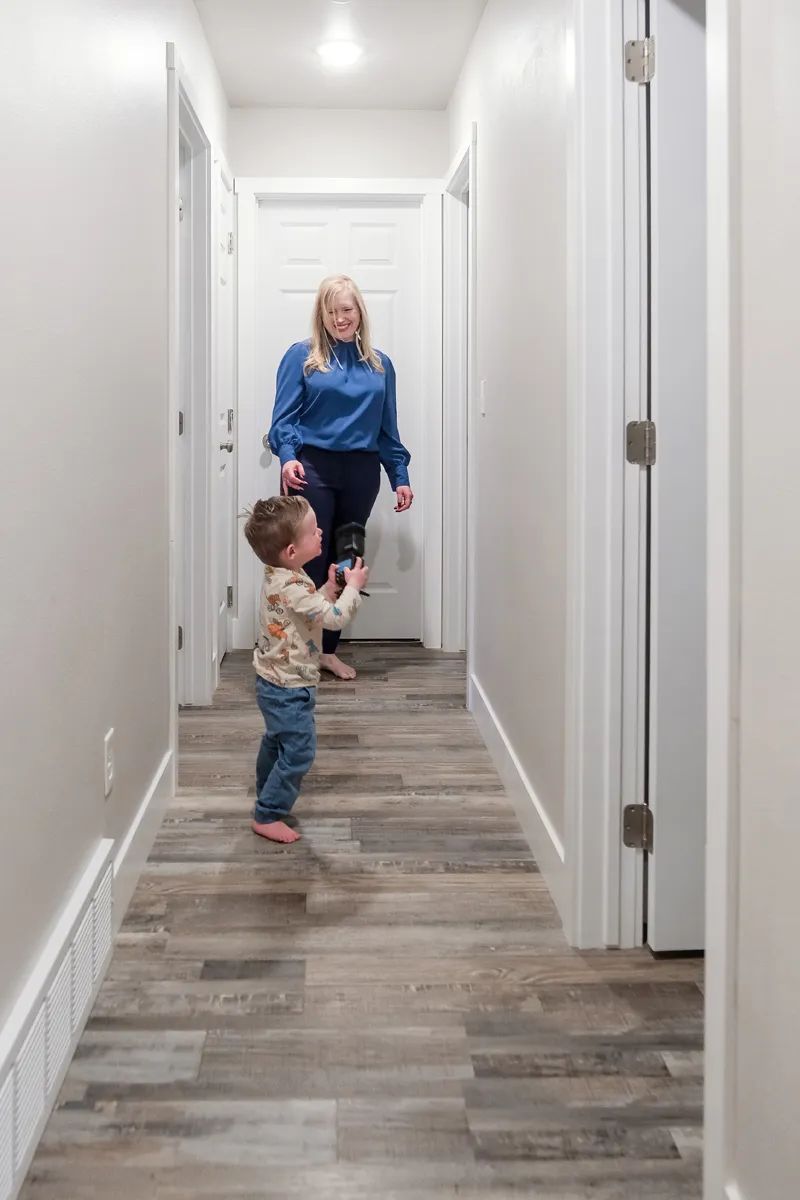
all about manipulation & control
Billings mom picks up the pieces after losing her home
Sledgehammer marks in every door and wall. An axe taken to a vintage bike. Blood-soaked floors from spoiled meat thrown all over the garage. Floorboards stained after an entire closet of clothes was soaked in urine.
On the walls of her 20-month-old son’s bedroom, scrawled in black spray paint, were the words, “You Broke My Heart.”
This is what April Deines came home to on May 27, 2023.

If you ask April what prompted the destruction, she says she remembers the words of her now ex-husband: “He said, ‘What is this? You are filing for divorce?’”
April says what happened next felt surreal.
“He said, ‘If you leave right now, I am going to smash every window in your car.’ Something about it — there was no light in his eyes,” she says. “They were black. There was nothing. At that instant, I just knew something was different.”
When she opened the door to their garage, she could hear air coming out of one of her tires.
“I didn’t stop,” April says. “I went around to the back of the car and put my son on my lap. He had already smashed my front windshield. There was glass everywhere.”
She says she slammed her car in reverse and took off down the canyon road leading into town. Her home was so remote that there was no cell service.
“It was a long way from 9-1-1,” April says. “When I fled, all I took was essentially my go-bag, which was a diaper bag which had a few hundred dollars, my gun, and diapers and that was it.” April says her husband had taken her cell phone wallet, so she had no phone, no driver’s license, and no credit cards.
She managed to make it to a gas station, driving her car with one tire on the rim before calling a friend and 9-1-1.

When she was able to come back to gather some belongings a few days later, she says, she was escorted by a sheriff’s deputy.
“The deputy that accompanied me warned me that the house was destroyed, and it was some of the worst he had seen in an attempt to prepare me,” April said later in a Facebook post.
She posted a handful of pictures showing the damage. That post garnered more than 8,500 comments and 17,000 shares. The images were both powerful and heartbreaking.
“I went through and picked up a box and a half of salvageable stuff, but he pretty much destroyed everything that was mine,” April says. “I was just in shock.”
What was perhaps the biggest shock was the fact that none of it was a crime.
“Nothing he did was illegal,” April says. “He was on the deed and we were married. He can do anything he wants to his property. It was a civil matter.” She adds, “Because I had the foresight to grab my son and run, we were not present for any of that. We weren’t injured, so he didn’t break any laws.”

Four years earlier, April says, the relationship had begun in an almost storybook fashion. After meeting online, the couple got engaged at the summit of Mount Kilimanjaro in Tanzania. It was always a dream of April’s to climb it. She never expected a marriage proposal but, at the time, it felt like the icing on the cake. The two were married in February of 2020.
“It was the highest of highs to the lowest of lows,” April says.
Over the years, she says, there were red flags in their relationship. First, there was the whitewater rafting trip in Gardiner.
“A kid doored my car and he lost his shit on this kid,” April says. “The police were called, and my husband had said his family had assaulted him and he went for his gun. That was what I was told.” After filing a Freedom of Information Act request, April says, “It turned out he was the one who assaulted the kid. They were a family from out of state and they didn’t want to press charges because they were just on vacation.”
April says what came next was another red flag.
“He started yelling at me, telling me that it was all my fault, and I was just a stupid bitch,” she says. “My friend was like, ‘You will not talk to her like that,’ and he just lost it.”
She says he didn’t talk to her for weeks and, instead, locked himself in his gun room for weeks on end.
“He’d be gone when I came home from work. He’d make his presence known though,” April says. “There were dirty clothes in the living room. Pots and pans, just as big of a mess that he could make. I wouldn’t see him, but I’d feel his presence. He’d come home after I went to bed and the cycle would continue for weeks. It was a real mental game.”
It was a game, she says, that happened over and over in their relationship.
“It was all about manipulation and control,” April says.

What April describes is known as “coercive control,” a form of abuse that involves the use of threats, humiliation or intimidation to frighten a victim. It’s estimated that 60 to 80 percent of domestic abuse survivors experience some form of coercive control.
“The thing that surprised me was how many other women that I have met and interacted with that had similar stories and more severe stories than even mine,” April says. “That was the real eye-opener for me.”
She’s also come to understand how hard it is to leave.
“I think the devil you know is a lot easier than the unknown,” she says. “Do you go out on your own with no money, no friends, no resources? Or do you go back home where at least you know you have a bed to sleep in?” April adds, “Even if a victim confides in a friend, they might say well, that can’t be, he’s always so nice. They kind of reinforce that you are the crazy one.”
As she looks back to May of 2023, she says, “My saving grace was him destroying the house. When I saw the house, it was crystal clear. You can’t do all that damage to your child’s room and your family’s house and then make an apologetic call and think that everything is going to be OK.”
In the months to come, friends would create a GoFundMe account that ended up raising $25,619 to help her rebuild, since insurance didn’t cover any of the damage. April says a builder helped fix the drywall. Her friends held a painting party. But, perhaps one of the most emotional gifts came in the form of a comforter for her son.
“There is a girl who lives in the YWCA apartments. She was a survivor. She messaged me on Facebook, and she said, ‘Hey, I saw your post. I have a few things for you, a comforter for your son and a teddy bear. When you get a chance, come by and pick it up.’”
She gets emotional even sharing the story today.

“She was living there because her husband or boyfriend had killed their toddler. Talk about putting some things in perspective,” April says as she wipes a tear. “She lost everything, and at the time, I still had my job. I still had friends and family and a house, even though I couldn’t live there. But yet, here is this girl who lost her child because of domestic violence and she’s giving me a comforter? It was pretty awe-inspiring.”
Today, the house has been rehabbed and April put it on the market. While she was cleaning it out, she counted 30 firearms stocked in her husband’s gun room. She never knew he had that many. She currently has a protective order against him and in March he’s set for trial for violating it. She says he’s ordered to keep a distance of 1,500 feet, “because of his gun knowledge.”
April is no longer a commercial banker. She’s looking for a new place to stay and looking at life with a new lens of opportunity. She’s sharing her story in the hope of encouraging even one woman to leave her abuse behind.
“I’ve come a long way,” April says. “I can now say I am a survivor.”
Even today, however, she wonders what might have happened if she had stayed.
“Would I have been a news story as opposed to a Facebook post?” she says. “I wrestle d I have been a news story as opposed to a Facebook post?” she says. “I wrestle with that a lot.”
Editor's Note: Because April's husband wasn't charged with any crime other than violating a pprotective order, YVW used April's maiden name and chose not to name him in the story.
Coercive Control
Abuse hidden in plain sight
Coercive control is an act or a pattern of acts of assault, threats, humiliation and intimidation or other abuse that is used to harm, punish, or frighten their victim. Some examples include:
Isolating the victim from friends or family
Controlling what the victim eats, wears or does
Controlling who the victim can see or spend time with
Preventing the victim from accessing support
Monitoring the victim’s behavior online or tracking their movements through their car or phone.










